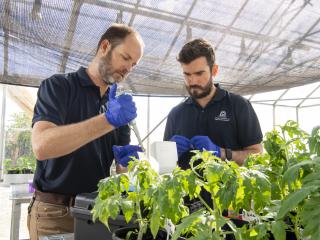Western Australia
March 24, 2021

DPIRD laboratory scientist Craig Webster (left) and research scientist Dr Ben Congdon test out the new LAMP technology to identify the pest fall armyworm in the field.
A new in-field molecular test to detect a significant pest threat to grain and horticulture crops has been developed to help protect production and profitability.
Fall armyworm (Spodoptera frugiperda), which was first detected in northern Western Australia in 2020, has been confirmed in horticulture crops as far south as Gingin but could also pose a risk to cereal, canola and pulse crops this spring.
In an Australian first, the Department of Primary Industries and Regional Development used Loop-mediated isothermal AMPlification (LAMP) technology to identify fall armyworm caterpillars, which can be very difficult to distinguish from other species.
Research scientist Ben Congdon said the test could accurately and rapidly identify fall armyworm at a molecular level in the field in under half an hour.
“First we developed our own primers, which are essentially small pieces of DNA specific to part of the fall armyworm genome that are required to run the assay test,” Dr Congdon said.
“Most importantly, sample preparation only needs a small piece of the caterpillar in water and does not require any heat blocks, centrifuges or special buffers.
“A very small amount of the extract is then added to the primers and LAMP reagent and processed by a portable LAMP machine in the paddock to provide a rapid, sensitive and specific detection of fall armyworm.”
The department has been testing the system in horticulture crops in the State’s north and validating the results with genomic sequencing to confirm the LAMP diagnosis.
Further infield validation will continue when the pest has the potential to be active in grain crops in spring.
Senior research scientist Helen Spafford said the LAMP fall armyworm test would enable horticulture and grain growers to identify the pest in the field rapidly and cheaply so they could take action to protect production and optimise profitability.
“Fall armyworm has only been present in WA for about a year so we are still learning how it performs in different crops and environments,” Dr Spafford said.
“Confirmation of an established and potentially damaging population relies on the detection of early instar larvae in the crop, which is critical to make informed management decisions.
“A key advantage is that the LAMP technique can also be used on very young caterpillars, which are particularly difficult to identify visually, allowing decisions to be made rapidly.”
Horticulture and grain growers, agronomists and gardeners are encouraged to report any suspect fall armyworm or damage to the department’s Pest and Disease Information Service at +61 (0) 9368 3080 or padis@dpird.wa.gov.au or via the MyPestGuide Reporter app.
More information about fall armyworm, including monitoring and management, is available here.